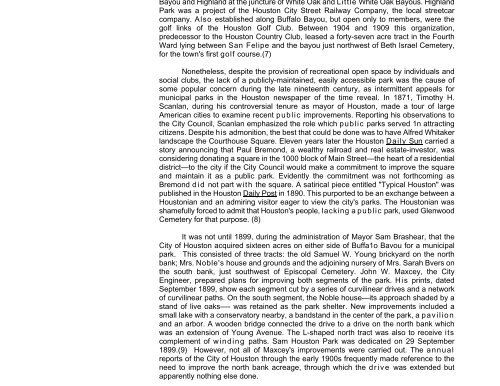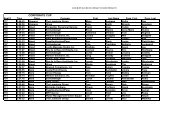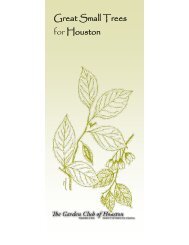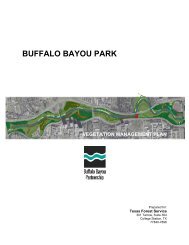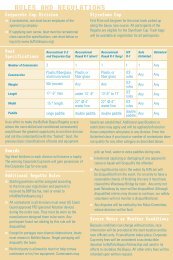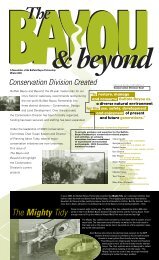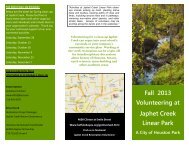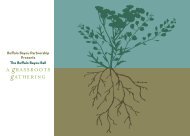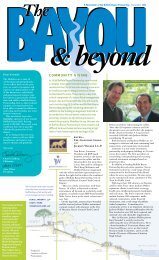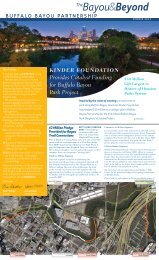History of the Shepherd to Sabine project area - Buffalo Bayou Park
History of the Shepherd to Sabine project area - Buffalo Bayou Park
History of the Shepherd to Sabine project area - Buffalo Bayou Park
You also want an ePaper? Increase the reach of your titles
YUMPU automatically turns print PDFs into web optimized ePapers that Google loves.
<strong>Bayou</strong> and Highland at <strong>the</strong> juncture <strong>of</strong> White Oak and Little White Oak <strong>Bayou</strong>s. Highland<strong>Park</strong> was a <strong>project</strong> <strong>of</strong> <strong>the</strong> Hous<strong>to</strong>n City Street Railway Company, <strong>the</strong> local streetcarcompany. Also established along <strong>Buffalo</strong> <strong>Bayou</strong>, but open only <strong>to</strong> members, were <strong>the</strong>golf links <strong>of</strong> <strong>the</strong> Hous<strong>to</strong>n Golf Club. Between 1904 and 1909 this organization,predecessor <strong>to</strong> <strong>the</strong> Hous<strong>to</strong>n Country Club, leased a forty-seven acre tract in <strong>the</strong> FourthWard lying between San Felipe and <strong>the</strong> bayou just northwest <strong>of</strong> Beth Israel Cemetery,for <strong>the</strong> <strong>to</strong>wn's first golf course.(7)None<strong>the</strong>less, despite <strong>the</strong> provision <strong>of</strong> recreational open space by individuals andsocial clubs, <strong>the</strong> lack <strong>of</strong> a publicly-maintained, easily accessible park was <strong>the</strong> cause <strong>of</strong>some popular concern during <strong>the</strong> late nineteenth century, as intermittent appeals formunicipal parks in <strong>the</strong> Hous<strong>to</strong>n newspaper <strong>of</strong> <strong>the</strong> time reveal. In 1871, Timothy H.Scanlan, during his controversial tenure as mayor <strong>of</strong> Hous<strong>to</strong>n, made a <strong>to</strong>ur <strong>of</strong> largeAmerican cities <strong>to</strong> examine recent public improvements. Reporting his observations <strong>to</strong><strong>the</strong> City Council, Scanlan emphasized <strong>the</strong> role which public parks served 1n attractingcitizens. Despite his admonition, <strong>the</strong> best that could be done was <strong>to</strong> have Alfred Whitakerlandscape <strong>the</strong> Courthouse Square. Eleven years later <strong>the</strong> Hous<strong>to</strong>n Daily Sun carried as<strong>to</strong>ry announcing that Paul Bremond, a wealthy railroad and real estate-inves<strong>to</strong>r, wasconsidering donating a square in <strong>the</strong> 1000 block <strong>of</strong> Main Street—<strong>the</strong> heart <strong>of</strong> a residentialdistrict—<strong>to</strong> <strong>the</strong> city if <strong>the</strong> City Council would make a commitment <strong>to</strong> improve <strong>the</strong> squ<strong>area</strong>nd maintain it as a public park. Evidently <strong>the</strong> commitment was not forthcoming asBremond d i d not part with <strong>the</strong> square. A satirical piece entitled "Typical Hous<strong>to</strong>n" waspublished in <strong>the</strong> Hous<strong>to</strong>n Daily Post in 1890. This purported <strong>to</strong> be an exchange between aHous<strong>to</strong>nian and an admiring visi<strong>to</strong>r eager <strong>to</strong> view <strong>the</strong> city's parks. The Hous<strong>to</strong>nian wasshamefully forced <strong>to</strong> admit that Hous<strong>to</strong>n's people, lacking a public park, used GlenwoodCemetery for that purpose. (8)It was not until 1899, during <strong>the</strong> administration <strong>of</strong> Mayor Sam Brashear, that <strong>the</strong>City <strong>of</strong> Hous<strong>to</strong>n acquired sixteen acres on ei<strong>the</strong>r side <strong>of</strong> Buffa1o Bavou for a municipalpark. This consisted <strong>of</strong> three tracts: <strong>the</strong> old Samuel W. Young brickyard on <strong>the</strong> northbank; Mrs. Noble's house and grounds and <strong>the</strong> adjoining nursery <strong>of</strong> Mrs. Sarah Bvers on<strong>the</strong> south bank, just southwest <strong>of</strong> Episcopal Cemetery. John W. Maxcey, <strong>the</strong> CityEngineer, prepared plans for improving both segments <strong>of</strong> <strong>the</strong> park. His prints, datedSeptember 1899, show each segment cut by a series <strong>of</strong> curvilinear drives and a network<strong>of</strong> curvilinear paths. On <strong>the</strong> south segment, <strong>the</strong> Noble house—its approach shaded by astand <strong>of</strong> live oaks—- was retained as <strong>the</strong> park shelter. New improvements included asmall lake with a conserva<strong>to</strong>ry nearby, a bandstand in <strong>the</strong> center <strong>of</strong> <strong>the</strong> park, a pavilionand an arbor. A wooden bridge connected <strong>the</strong> drive <strong>to</strong> a drive on <strong>the</strong> north bank whichwas an extension <strong>of</strong> Young Avenue. The L-shaped north tract was also <strong>to</strong> receive itscomplement <strong>of</strong> winding paths. Sam Hous<strong>to</strong>n <strong>Park</strong> was dedicated on 29 September1899.(9) However, not all <strong>of</strong> Maxcey's improvements were carried out. The annualreports <strong>of</strong> <strong>the</strong> City <strong>of</strong> Hous<strong>to</strong>n through <strong>the</strong> early 1900s frequently made reference <strong>to</strong> <strong>the</strong>need <strong>to</strong> improve <strong>the</strong> north bank acreage, through which <strong>the</strong> drive was extended butapparently nothing else done.


